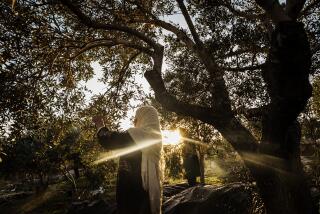Tree-Planting Project in Senegal Pushes Back Desert to Let Farmland Bloom Again
- Share via
M'BOUMBAYE, Senegal — The Sahara is moving into Africa’s Sahel region at a rate of nearly 50 feet a year, turning once-fertile farmland into desert. But here in a small part of Senegal a determined people have stopped it.
Behind dunes of fine white sand that clings to everything are small patches of green in this part of the largely parched Sahel, the area just below the Sahara Desert.
The desert has been beaten back in the Niayes, a narrow coastal band three to six miles wide.
Where villagers once had to rebuild their thatched homes year after year as the shifting dunes engulfed them, gardens now burst with cabbages, carrots, tomatoes, cucumbers and other vegetables.
Trees Planted
The fight began seven years ago, when the United States, Canada and the United Nations started planting trees as windbreaks against the unrelenting desert.
The dune stabilization project in the Niayes extends from Dakar, Senegal’s capital, 115 miles north to Saint Louis at the mouth of the Senegal River.
A similar project run by CARE in Niger, another Sahel nation, resulted in a 20% increase in food production, mainly millet. Steve Dennison, who evaluated that project’s effectiveness said that windbreaks “could make the difference in survival in marginal areas.”
In M’Boumbaye, just south of Saint Louis, is the headquarters for the 20-mile-long Canadian project. The 35-mile-long U.S. effort has its headquarters in Kayar at the other end of the Niayes near Dakar. The U.N. project focuses on a 60-mile central stretch.
Firewood, Grazing
Before the project started, M’baiye N’yang watched huge mounds of shifting desert sands swallow up his vegetable gardens.
A combination of factors were at work in the destruction of the once-fertile area. N’yang and his neighbors cut down trees for firewood, robbing the land of its natural protection from an eroding sea breeze.
At the same time, cattle overgrazed the land and then a six-year drought sped the desert’s advance.
Now, N’yang’s area is green again, thanks to a 200-yard-wide windbreak of Australian pines.
‘Animals Coming Back’
“Even the animals are coming back,” said Silla Khouna, the Senegalese forestry official in charge of the desert reclamation project at Kayar. “As you can see, there is a forest where there was nothing but sand just five years ago. The small animals are back. Listen, you can even hear birds singing.”
A profusion of gardens lay in the sheltered area behind the forest.
The 6,000 sheltered gardens of the Niayes produce 140,000 tons of vegetables of all kinds for the markets in Saint Louis and Dakar.
“I have to water my plants often, at least every other day,” N’yang said. “But there is really no problem. The trees stop the wind and the water doesn’t evaporate as rapidly as it used to. The garden grows well now.”
6,000 Wells Dug
Part of the project has been the digging of more than 6,000 wells. Averaging 10 to 15 feet deep, the simple concrete wells serve more than 30,000 people of the Niayes.
But the region’s resurgence has its potential problems.
Nomadic herdsmen are moving in from dry areas and becoming farmers, competing with the Niayes people for the little fertile land that is available.
“It is a real political problem,” Khouna said. “It is up to me to decide who gets these reclaimed areas. It isn’t always easy, because we have more people who want to use the land than we have land to make available to them.”
More to Read
Sign up for Essential California
The most important California stories and recommendations in your inbox every morning.
You may occasionally receive promotional content from the Los Angeles Times.










